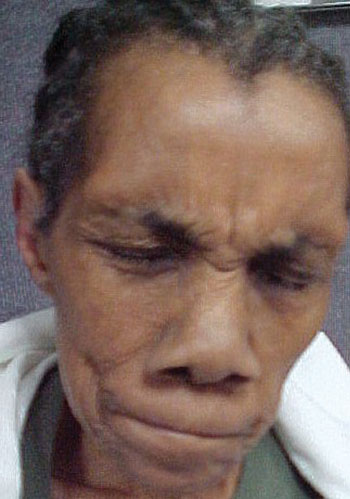 |
| External image of our 67-year-old patient who presented with a facial spasm. What is the most likely diagnosis? |
A 67-year-old black female presented for a consult regarding an unusual facial spasm after being admitted to the hospital 15 days earlier for multiple systemic illnesses. She did not experience any local or generalized head pain, but reported an increase in blinking and “eyelid twitching” as early as five to seven years ago.
Her systemic history was remarkable for medically controlled arrhythmia and hypertension. She reported no known allergies of any kind.
Diagnostic Data
Her best-corrected visual acuity measured 20/20 OU at distance and near. We uncovered no evidence of afferent pupillary defect. Additionally, the external, corneal and internal ocular evaluations were normal.
The dilated fundus examination was normal. Her intraocular pressure measured 14mm Hg OU. The pertinent clinical finding is illustrated in the photograph.
Your Diagnosis
How would you approach this case? Does the patient require any additional tests? What is your diagnosis? How would you manage this patient? What is the likely prognosis?
Discussion
Initial questioning during the patient history should include a description of symptom severity. Additional testing should consist of an evaluation and comparison of bilateral facial sensations, as well as neuroimaging to rule out compression secondary to a mass or aneurysm.
The diagnosis in this case is essential blepharospasm of the eye and facial muscles, or Meige’s syndrome. Affected patients frequently complain of photophobia and dry eye, as well as exhibit a gradual increase in blink frequency, force and duration over a two to seven year period.1 The condition often results in intermittent functional blindness due to the patient’s inability to control lid spasms and open his or her eyes.1-3
Factors that exacerbate the disease include stressful situations, such as those encountered at work or in social settings. As with other dystonias, patients are often able to employ “sensory tricks” to arrest the spasms temporarily. These include whistling, singing and the application of pressure to specific locations on the face.1
Over time, the spasms may spread to involve the mid-face. As the disease progresses , patients frequently complain of difficulty talking, eating and swallowing. In severe cases, pronounced bruxism occurs (jaw clenching), resulting in problems with dentition and subsequent malnutrition.1-3
Other associated features may include decreased tear production, secondary adjacent dystonias (e.g., spastic dysphonia and torticollis, and respiratory dysfunction) and anatomic changes (e.g., eyelid and brow ptosis, dermatochalasis, entropion and canthal tendon abnormalities).1,3
The anatomic site and the biochemical basis of essential blepharospasm is unknown. Most academic clinicians recognize abnormalities in the basal ganglia or midbrain.1,3 Abnormal auditory brain stem response potentials have been documented in patients who have benign essential blepharospasm (BEB) and Meige's syndrome, which implicate brain stem involvement.1 Additionally, abnormal levels of neurotransmitters have been noted in the midbrain and brain stem nuclei of patients with Meige's syndrome. Further, researchers have isolated hyperactivities of the central dopaminergic and noradrenergic neurones as part of the condition’s pathophysiology.1,2
The treatment of choice for BEB and Meige’s syndrome is botulinum toxin type A.1,4 This is one of seven antigenic-specific neurotoxins (A, B, C1, D, E, F and G) produced by the bacterium Clostridium botulinum. This neurotoxin blocks neuromuscular transmission and reduces muscular contraction by acting on peripheral cholinergic nerve endings to prevent acetylcholine release from presynaptic terminals.4 The onset of effect occurs within 24 to 72 hours following treatment, with a typical therapeutic plateau at three to five days. Occasionally, however, the agent’s effect is delayed for as long as two to four weeks.1
The recommended starting dose for botulinum toxin type A is 1.25 to 5.0 units per injection site. If a suboptimal response occurs, the dose should be doubled.1,4
The mean duration of denervation is three months for BEB, and slightly longer for hemifacial spasm.1 Frequently, the procerus and corrugator muscles also are involved and require injection. Other periorbital or facial sites may require treatment. Frequently, injections in the lower lid alone yield a pronounced effect on spasms in the lower face––thus reducing dosage requirements.1,4
The major adverse reactions to botulinum toxin include ptosis, epiphora, keratitis, dry eye and diplopia. These effects usually are transient and resolve long before the beneficial effects of the drug are exhausted. A flu-like syndrome also has been reported following high-dose botulinum toxin injections for blepharospasm.1 Further, studies suggest the possibility of a transient intraocular pressure increase and an abnormal emptying of the gallbladder (with secondary biliary colic) as potential side effects.1,4
Unfortunately, our patient refused botulinum treatment––despite explanations of its therapeutic benefits from both the ophthalmology and neurology departments.5
1. Faucett D. Essential blepharospasm. In: Yanoff M, Duker JS. Philadelphia: Mosby; 1999: 7.10.1-4.
2. Yoshimura R, Kakihara S, Soya A, et al. Effect of clonazepam treatment on antipsychotic drug-induced Meige syndrome and changes in plasma levels of GABA, HVA and MHPG during treatment.
Psychiatry Clin Neurosci. 2001 Oct;55(5):543-6.
3. Kirton CA, Riopelle RJ. Meige syndrome secondary to basal ganglia injury : a potential cause of acute respiratory distress.
Can J Neurol Sci. 2001 May;28(2):167-73.
4. Neuenschwander MC, Pribitkin EA, Sataloff RT. Botulinum toxin in otolaryngology: a review of its actions and opportunities for use.
Ear Nose Throat J. 2000 Oct;79(10):788-9, 792, 794.
5. Ruusuvaara P, Setälä K. Long-term treatment of involuntary facial spasms using botulinum toxin. Acta Ophthalmol (Copenh). 1990;68(3):331-8.

